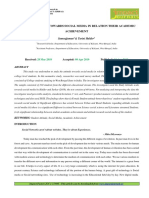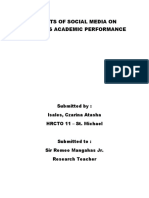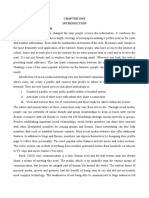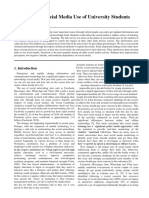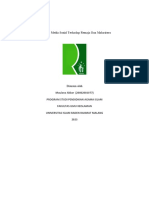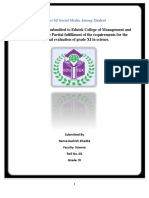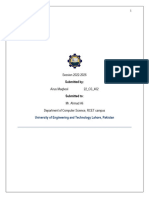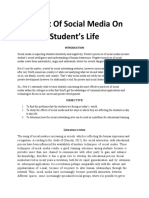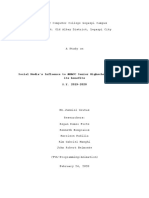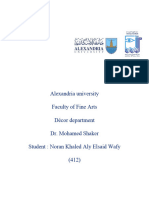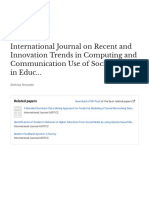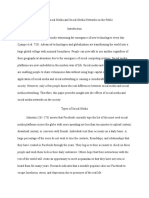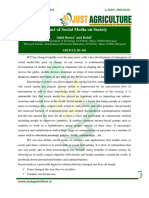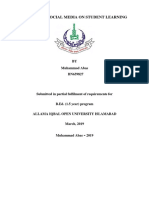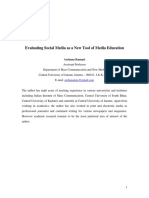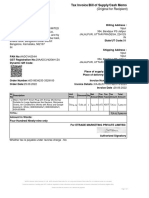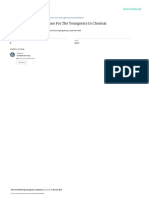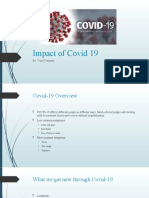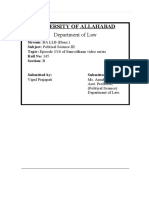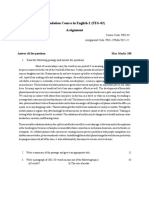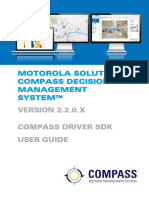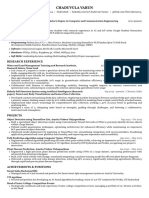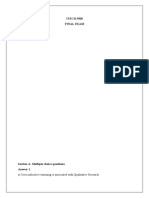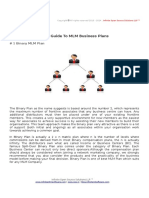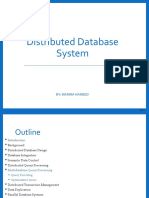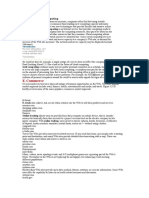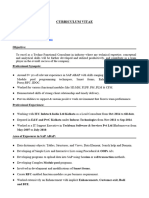CCIJHSS 610 129-132c
CCIJHSS 610 129-132c
Uploaded by
Vipul PrajapatoCopyright:
Available Formats
CCIJHSS 610 129-132c
CCIJHSS 610 129-132c
Uploaded by
Vipul PrajapatoOriginal Title
Copyright
Available Formats
Share this document
Did you find this document useful?
Is this content inappropriate?
Copyright:
Available Formats
CCIJHSS 610 129-132c
CCIJHSS 610 129-132c
Uploaded by
Vipul PrajapatoCopyright:
Available Formats
Cross-Currents: An International Peer-Reviewed Journal on Humanities & Social Sciences
Abbreviated Key Title: Cross Current Int J Peer Reviewed J Human Soc Sci
ISSN: 2394-451X (Print) & Open Access
DOI: 10.36344/ccijhss.2020.v06i10.003
Volume-6 | Issue-10|October-2020 | Review Article
Social Media: Bane or Boon for Students
Muzamil Aziz Dar1*, Dr. R. Neelakandan2
1
M. Phil Scholar, Department of Psychology, Annamalai University, Tamil Nadu, India
2
Assistant professor, Department of psychology, Annamalai University, Tamil Nadu, India
*Corresponding author: Muzamil Aziz Dar | Received: 13.10.2020 | Accepted: 26.10.2020 | Published: 30.10.2020 |
Abstract: The present era is known as the Networking era and social networking sites are one of the most widely used platforms offered by internet.
During this era, young people especially students have taken keen interest in communication on these social networking sites. During past decade, a
number of studies have been conducted on the effects of social media on the student’s academic performance. In this study, the concise review of past
studies focuses on the findings to know the exact effect of social media on students. From the results of different studies, it is concluded that effect of
social media on students academic performance remains a controversial issue and hence, social media is described as a double edged sword (i.e. It has
positive as well as negative effects), about which users especially students must be trained to be aware of its dangers and should be prudent in its
utilization.
Keywords: Social Networking Sites: A forms of online platforms that allow users to create a public profile and interact with other users on the
website. Academic Performance: It represents the performance outcomes that indicate the extent to which a person has accomplished specific goals
that were the focus of instructional environments, especially in schools, colleges and universities. Mental Health: It refers to the social, cognitive and
emotional well-being of an individual.
INTRODUCTION social media can be used to connect with other people,
The advent of internet in 1990s has created a whether for business or commercial purposes, make
platform for millions of computers at numerous sites in new friends, reawaken old friends and long lost
all countries, belonging to thousands of institutions and relatives. In addition to this, some people have found
other organizations to link up with one another. Now social media as a means of entertainment and for others;
the world is enjoying the innovations in different it is the cheapest means to display their skills to the
technologies but the most influenced one is world. In simple words, social media has changed the
communication field which has led to the introduction ways of thinking, behaving and living of new
of Social Networking Sites (SNSs). These Social generation up to the extent where it has become our
Networking Sites allows the users to create a user significant other without whom our life will be like a
profile and setup an account to create a digital identity fish without water.
of the user. It also allows the users to select other
members of the site as friends (on face-book) or Zephoria Inc [2], on Facebook, 1.79 billion
followers (on instagram and twitter) and most of all it users are on a monthly basis worldwide, 4.5 billion
allows it allows the users to communicate with one Likes are generated daily and 1.8 billion Loggins are
another. The evolution of these Social Networking Sites experienced daily, thus creating a web inside a web.
(SNSs) has led its usage as best medium of Now could you imagine the number of all students
communication whereby two third (2/3) of the total logging into these social media applications every day?
internet population visits these Social Networking Sites The answer will be definitely in millions and millions
which are commonly termed as SOCIAL MEDIA [1]. of students. Millions of students Login to their social
The innovation of social media has turned the dream of media accounts like , Facebook, Instagram, Twitter,
´´global village`` into a reality wherein billions and WhatsApp, Tiktok, PubG etc as a part of their everyday
billions of people communicate with one another routine.
through these social networking sites (SNSs).
As we know, none of the inventions in this
Now this social media has become more than world is completely one sided, i.e. There are always two
just a means of communication as it gives us ease in sides of a same coin. Thus it is not surprising as it is the
various aspects of life such as shopping, travelling, same case with social media, as it comes with positive
seeking new information, education and electronic as well as negative effects.
messaging. Present generation (21st) discovered that
Quick Response Code
Copyright © 2020 The Author(s): This is an open-access article
distributed under the terms of the Creative Commons Attribution 4.0
International License (CC BY-NC 4.0) which permits unrestricted
use, distribution, and reproduction in any medium for non-commercial
use provided the original author and source are credited.
Journal homepage:
https://crosscurrentpublisher.com/ccjhss/
Published By SAS Publisher, India 129
Muzamil Aziz Dar & R. Neelakandan; Cross Current Int J Peer Reviewed J Human Soc Sci, Oct, 2020; 6(10): 129-132
Positive Effects of Social Media: Now a day’s media as the cause of emotional disturbance, some
social media can be used for a wide range of viable blamed as the cause of eating disorder and some have
activities by students like for information seeking, labeled it as the root cause of behavioral change. The
attending online conferences and workshops, enhancing students using social media Apps especially Facebook,
bond between students and teachers, understanding instagram, whatsApp, Tiktok and PubG, spend
abstract concepts by 3D animations and many more. increasing amount of their quality time which in turn
Students academic life has transformed into a different negatively effects the students’ academic performance
style by the introduction of social media and large and social behavior [12]. Also Ayvonne Kelly et al.,
number of studies have affirmed that social media plays [13] carried out a study on ´´Social Media Use and
an important role on students in higher education. One Adolescents Mental Health `` to examine whether social
such study was conducted by Wheeler and Yeomans media is associated with mental health. Findings of
[3], in the study, the results revealed four (4) major their study clearly revealed that there is a significant but
advantages of social media usage by students in higher negative relationship between social media use and
education which include; enhancing relationships, mental health of students. This negative influence of
improving learning motivation, offer personalized social media on mental health directly affects their
course material and developing collaborative abilities’ (students) academic achievements. Furthermore, Owusu
is also observed that a greater percentage of students M Achaew and Agath Gifty Larson [14], examined that
including PhD scholars commonly use social media to social media usage had negatively affected the
ameliorate their studies [4]. The size of friendship on academic performance of the students. It has been also
social media has a significant impact on students’ observed that use of social media contributes to lower
performance and factors like daily usage of social academic performance, lower self-perception and less
media in hours has no significant effect on the students’ interest in college oriented careers [15]. Davies and
academic performance [5]. Also from the study of Cranston [16], also highlighted some of the risks
Muhammad Osama Shafiq and Falak Nazi [6], the associated with social media which include criminal
results revealed an interesting fact that frequent use of activities, such as identity theft and fake relations which
Facebook and WhatsApp does not affect studies of are prevalent now a days, sexual harassment and
students rather it enhances collaborative learning among unsuitable advertising. On the same direction O`Keefle
university students. Moreover, Zahid Amin et al., [7], and Clake Pearson [17], also mentioned cyber bullying ,
conducted a study on ´´ Impact of Social Media on online harassment, Facebook depression and privacy
Students Academic Performance`` wherein results concerns as some of the challenges associated with
revealed that there is significant effect of social media social network sites. Besides of these effects, other
on academic performance of students as it was evident studies conducted by a number of scholars proved that
from the results that there is a moderate positive social media can be detrimental to students’ academic
correlation between students and Facebook. Also the life if caution is not taken on time. For instance, the
study carried out by Jain et al., [8], titled ´´ The Impact study conducted by Obi et al., [18], titled ´´ The Need
of Social Networking in Promoting Education`` for Safety Consciousness among Youths on Social
revealed that social media has positive effect on Networking Sites`` revealed that social media affects
students by chatting with other students, teachers and students use of English. Most of the user s(Students)
external sources to acquire knowledge. It is further use short-handwriting when chatting with friends and
buttressed from the study of Yunus and Salehi [9] that unconsciously get used to it, thereby replicating same
students gained more vocabulary, improved their mistakes during examinations. This may seem that these
writing skills and reduced their spelling mistakes errors are minor challenges, but it is the matter of
through the use of social media. Finally the studies concern that the increasing rate at which these errors are
conducted by Arquero and Esteban [10] and Selwyn replicated in education sector and if care is not taken
[11], whose conclusions were that social media now, our future generation may see it as a norm. Indeed
undoubtedly generate new opportunities to engage a number of studies including the study of
students in higher education as they are remarkably Kuppuswamy and Narayan [19], among others have
effective at connecting people and facilitating the revealed unequivocally that social media is a nuisance
exchange of information. to students academic life. In their study they argued that
social media distracts the attention and concentration of
Negative Effects of Social Media students toward learning and converts it towards non
The number of students using social media is educational activities such as useless and unnecessary
surprisingly in millions and most of the students having chatting.
been blamed various social media applications for their
steady decrease in grades. Most of the users (students) CONCLUSION
of these social media apps complaint different health The conclusion of this study remains
related problems because of the overuse over use of controversial as it is clear from the review of past studie
these social media sites. Some students blamed social
Published By SAS Publisher, India 130
Muzamil Aziz Dar & R. Neelakandan; Cross Current Int J Peer Reviewed J Human Soc Sci, Oct, 2020; 6(10): 129-132
that the innovation of Social Media has negative as well media sites that may be prone to distracting
as positive effects on students academic performance, their attention during lectures.
sch as steady decrease in grades, distraction of attention 7. Students should be trained to use social media
in academic work, lack of privacy, bullying judiciously to ensure that they will not become
victimization, sexual harassment, wastage of their detrimental to their academics.
quality time and many more. But it (social media) also 8. All academic institutions should create their
have unlimited benefits like online lectures, enhancing own pages or groups on different social media
relations, reducing gap between teacher and student, sites to enhance academic performance.
keeping updated with all school activities, watching 9. The students should be trained to keep a
important lectures repeatedly, seeking new information, balance between chit-chatting and academic
understanding abstract concepts, attending online activities.
conferences & workshops and much more. So 10. School teachers and college lecturers and
undoubtedly, one can say that social media is and will professors should ensure to adopt new
remain an important tool in the field of education. It strategies and using social media as a tool to
supports different forms of education like E-Learning improve the academic performance by
and Distance education which have been widely channeling assignments and discussions on
patronized and facilitated to great extent through these social media.
social networking sites. Now acquiring information
both locally and internationally from friends, lecturers REFERENCES
or experts is no longer a struggle as it was in olden 1. Boyd, D. M., & Ellison, N. B. (2007). Social
days. In the end it will not be a mistake to say that Network Sites: Definition, History and
´social media is a useful servant but a dangerous Scholarships. Journal of computer-mediated
master` as it has been revealed from findings of communication, 13(1):210-230.
different studies that despite the positive effects of 2. Zephoria. (2017). The Top 20 Valuable Facebook
social media on students academic performance, there Statistics. https://zephoria.comac/top-20-
are some cases of distraction of attention and addiction valuable-facebook-statistics/amp/.
of social media which could have serious consequences 3. Wheeler, A., Yeomans, P., & Wheeler, D. (2008).
on the academic achievement of students. Finally, The Good, The Bad and the Wiki: Evaluating
Social Media can be described as a ´´Double Edged Student-Generated Content for Collaborative
Sword`` about which users especially students must be Learning. British Journal of Educational
aware about its dangers and should be prudent in its Technology, 39(6), 987-995.
utilization. 4. Khan, S. (2010). Impact of Social Networking
Websites on Students.Abasyan journal of Social
RECOMMENDATIONS Science, 5(2), 56-77.
After understanding the dual nature of social media, the 5. Samson, A. A., Dorcas, M. O., Bosede, O. O., &
following recommendations are made; Godspower, P. O. (2017). Impact of Social
1. Students should be made aware about the dual Networking Media Usage on the Academic
nature (positive & negativ effects) of social Performance of Students of the Redeemer`s
media on their academic achievements. University. International Journal of Engineering
2. Students should be monitored by parents and Research and Development. 13(10), 56-66.
teachers on how they use social media by 6. Muhammad, O. S., Falak, F. N. (2017). Use of
checking their activity log, notifications and Social Networks for AcademicsiIn Private
last seen status etc. Universities of Karachi: A Statistical Survey
3. Teachers should encourage the students about Approach. Journal of Basic and Applied Science,
the meaningful and fruitful ways of using 13, 626-631.
social media. 7. Zahid A., Ahmad, M. S., & Faisal, H. (2016).
4. Communication commissions of all countries Impact of Social Media of Students Academic
and network providers should come up with Performance. International Journl of Business and
different filtering information procedures that Management Invention. 5(4):22-29.
will prohibit the unwanted, unnecessary and 8. Jain, N., Ashish, V., Rama, S., & Tiwari, P.
sexual curiosity arising contents to reach (2012). Going Social: the Impact of Social
students. Networking in Promoting Eduacation.
5. Students must minimize the time they spend International journal of computer science. 3(9),
on these social sites to avoid being addicted of 483-485.
unnecessary chatting and entertainment. 9. Yunus, M., & Salehi, H. (2012). The Effectiveness
6. School, college and university authorities of Facebook Groups on Teaching and Improving
should also restrict access to certain social Writing: Students’ Perceptions. International
Published By SAS Publisher, India 131
Muzamil Aziz Dar & R. Neelakandan; Cross Current Int J Peer Reviewed J Human Soc Sci, Oct, 2020; 6(10): 129-132
journal of education and information https://www.iiste.org/journals/ndex.php/JEP/articl
Technologies, 6. Retrieved from e/view/20048.
research.iaun.ac.ir>pdfs>paperM-778. 15. Maya, K. G. (2015). Achievement Scripts, Media
10. Arquero, J. L., & Esteban, R. (2013). Using Social Influences on Blacks Students’ Academic
Network Sites in Higher Education: An Performance, Self-Perceptions and Carrier
Experience in Business Studies. Journal of Interests. Journal of Black psychology, 42(3):195-
innovations in education and teaching 220.
international. 16. Davies, T., & Cranston, P. (2008). Youth Work
DOI:10.1080/14703297.2012.760772. and Social Networking. National youth agency
11. Selwyn, N. (2007). The Use of Computer and research. Retrieved from
Technology in University Teaching and Learning: http://www.nya.org.uk/resource/youth-work-
A Critical Perspective. Journal of computer social-networking.
assisted learning, 23(2). DOI: 10.1111/j.1365- 17. O’Keeffe, G. S., & Clake-pearson, K. C. (2011).
2729.2006.00204.x. The Impact of Social Media on Children,
12. Akubugwo, I., & Maria, B. (2013). Influence of Adolescents and Families. American Academy of
Social Media on Social Behavior of Post Graduate Peadiatrics. Retrieved from
Students: A Case of Salford University, United pediatrics.aappublications.org.
Kingdom. IOSR Journal of Research & Method in 18. Obi, N. C., Bulus, L. D., Adamu, G. M., & Sala’at,
Evaluation (IOSR-JRME). 3(6):39-43. A. B. (2012). The Need for Safety Consciousness
13. Kelly, Y., Zilanawala, A., Booker, C., & Sacker, among Youths on Social Networking Sites.
A. (2018). Social media use and adolescent mental Journal of Applied Science and management
health: Findings from the UK Millennium Cohort (JASM), 14(1).
Study. EClinicalMedicine, 6, 59-68. 19. Kuppuswamy, S., & Narayan, P. (2010). The
14. Owusu, A., & Agatha, G. L. (2015). Use of Social Impact of Social Networking Websites on the
Media and its Impacts on Academic Performance Education of Youth. Internal journal of virtual
of Tertiary Students. A Case Study of Koforidua Communities and Social Networking (IJVCSN),
Polytechnic, Ghana. Journal of education and 2(1) 67-79.
practice, 6. Retrieved from
Published By SAS Publisher, India 132
You might also like
- Effects of Social Media To The Daily Lives of Generation ZDocument16 pagesEffects of Social Media To The Daily Lives of Generation ZMaricris MoralesNo ratings yet
- Effects of Social Media To The Learning Process of 11 Stem StudentsDocument84 pagesEffects of Social Media To The Learning Process of 11 Stem StudentsASTRAL ROCKET100% (1)
- Hunter Wheel Alignment Software UpdateDocument3 pagesHunter Wheel Alignment Software UpdateOscar Daniel ManzottiNo ratings yet
- BDO User Navigation For System AdministratorDocument4 pagesBDO User Navigation For System AdministratorJuly FermiaNo ratings yet
- Level of Awareness On Social Media Platforms Among The Employees of Kalinga State University Bulanao CampusDocument23 pagesLevel of Awareness On Social Media Platforms Among The Employees of Kalinga State University Bulanao CampusIJELS Research JournalNo ratings yet
- A Study On Positive and Negative Effects of Social Media On SocietyDocument8 pagesA Study On Positive and Negative Effects of Social Media On SocietyAleksandr BinamNo ratings yet
- The Impact That Social Media Has Had On Today's Generation of Indian Youth: An Analytical StudyDocument9 pagesThe Impact That Social Media Has Had On Today's Generation of Indian Youth: An Analytical StudyIJELS Research JournalNo ratings yet
- Ijrar Issue 20542888Document7 pagesIjrar Issue 20542888Kowther Nor HassanNo ratings yet
- Student Attitude Towards Social Media in Relation Their Academic Achievement-2019-04!13!11-32Document12 pagesStudent Attitude Towards Social Media in Relation Their Academic Achievement-2019-04!13!11-32Impact JournalsNo ratings yet
- Effects of Social Networking Media To The Academic Performance of The StudentsDocument6 pagesEffects of Social Networking Media To The Academic Performance of The StudentsBad SleeperNo ratings yet
- The Influence of Social Media On EducationDocument4 pagesThe Influence of Social Media On EducationInternational Journal of Innovative Science and Research TechnologyNo ratings yet
- Charity 3Document10 pagesCharity 3Nnamani EmmanuelNo ratings yet
- Social Media and ChildrenDocument14 pagesSocial Media and ChildrenAndrew SamuelNo ratings yet
- A Study On Positive and Negative Effects of Social Media On SocietyDocument10 pagesA Study On Positive and Negative Effects of Social Media On SocietyNaveed Bashir100% (1)
- RationaleDocument5 pagesRationaleBrittney D MinahalNo ratings yet
- SocialmediaDocument6 pagesSocialmediamynameismanasrajNo ratings yet
- Research PaperDocument10 pagesResearch PaperRochak AdhikariNo ratings yet
- Social Media and ChildrenDocument14 pagesSocial Media and ChildrenRhianah Geil ModestoNo ratings yet
- EssayDocument10 pagesEssayakku141104No ratings yet
- Chapter One 1.1 Background To The StudyDocument21 pagesChapter One 1.1 Background To The StudySinger JerowNo ratings yet
- Effects of Social Media On Students Academic Performance Chapter 1 and 2Document10 pagesEffects of Social Media On Students Academic Performance Chapter 1 and 2Charles Sunga100% (1)
- Book Design AssignmentDocument120 pagesBook Design AssignmentFrederick AgyemangNo ratings yet
- English Project 12 SamyuDocument10 pagesEnglish Project 12 SamyuVISHAL S. VNo ratings yet
- Makalah TTG Socmed (New)Document23 pagesMakalah TTG Socmed (New)JombloDeatNo ratings yet
- Social Media Exposure and Influence On ADocument73 pagesSocial Media Exposure and Influence On AMohan JimmyNo ratings yet
- A Study On Social Media and Its Impact On YouthDocument10 pagesA Study On Social Media and Its Impact On YouthAlok Kumar MauryaNo ratings yet
- Behaviour 1-3Document21 pagesBehaviour 1-3Singer JerowNo ratings yet
- Are Social Network Good For Our Society?: (CITATION Soc15 /L 1033)Document4 pagesAre Social Network Good For Our Society?: (CITATION Soc15 /L 1033)Mümtă GhällĕyNo ratings yet
- A Study of University Students CommunicaDocument11 pagesA Study of University Students CommunicahyrumpieNo ratings yet
- Social NetworkingDocument3 pagesSocial NetworkingEditor IJTSRDNo ratings yet
- Bago NamanDocument26 pagesBago NamanBENEDICT JAMES ARADANo ratings yet
- Social MediaDocument11 pagesSocial MediaNoel MKNo ratings yet
- SocialmediaDocument6 pagesSocialmediaPom PomNo ratings yet
- Social Media Usage Among College Students Research ReportDocument36 pagesSocial Media Usage Among College Students Research ReportmohitNo ratings yet
- Impact of Social Media Use of University Students - RemovedDocument8 pagesImpact of Social Media Use of University Students - RemovedHasibul IslamNo ratings yet
- Maulana Akbar (20862081077) WPS OfficeDocument8 pagesMaulana Akbar (20862081077) WPS OfficeMaulana AkbarNo ratings yet
- English ProjectDocument18 pagesEnglish ProjectAshish KhadkaNo ratings yet
- Final Revision Chapter 1 To 4Document137 pagesFinal Revision Chapter 1 To 4Christly CallenoNo ratings yet
- A Research Project Report RUTU JENUDocument34 pagesA Research Project Report RUTU JENUtirthNo ratings yet
- Introduction WPS OfficeDocument3 pagesIntroduction WPS OfficeYuan MalomaNo ratings yet
- Research FinalDocument15 pagesResearch Finalcybil villadiegoNo ratings yet
- 22 CS 402 RapportDocument27 pages22 CS 402 RapportAirus MaqboolNo ratings yet
- Impact of Social Media On Society in A Large and Specific To TeenagersDocument5 pagesImpact of Social Media On Society in A Large and Specific To TeenagersJustine Dave FadriquelanNo ratings yet
- FinalllllllllDocument15 pagesFinalllllllllTrixie JordanNo ratings yet
- Tugas MakalahDocument15 pagesTugas Makalahita91itaNo ratings yet
- DSC Project Group 1Document4 pagesDSC Project Group 1Pulkit JainNo ratings yet
- Influence of Social Media and Its BenefitsDocument37 pagesInfluence of Social Media and Its BenefitsNays WanNo ratings yet
- Article 2Document12 pagesArticle 2Vidhi MNo ratings yet
- Ugong Senior High SchoolDocument6 pagesUgong Senior High SchoolLouisse CassandraNo ratings yet
- Argumentative Essay-Mirza Sadan Baig (26677)Document3 pagesArgumentative Essay-Mirza Sadan Baig (26677)baigsadanNo ratings yet
- Social MediaDocument47 pagesSocial Medianorankhaled14No ratings yet
- Unit-13-Social Media and Social PsychDocument22 pagesUnit-13-Social Media and Social PsychAarohi PatilNo ratings yet
- The Influence of Social Media On Economic Growth in The Society ProjectDocument58 pagesThe Influence of Social Media On Economic Growth in The Society ProjectBatifeNo ratings yet
- Negative - Impact - 2 With Cover Page v2Document6 pagesNegative - Impact - 2 With Cover Page v2Het YetNo ratings yet
- UntitledDocument12 pagesUntitledJimmyNo ratings yet
- Impact of Social Networking Sites A Sociological StudyDocument6 pagesImpact of Social Networking Sites A Sociological StudyEditor IJTSRDNo ratings yet
- Impact of Social Media On SocietyDocument5 pagesImpact of Social Media On Societyshoiabmalik002No ratings yet
- The Dark Side of Social Media A Reality Becoming MDocument17 pagesThe Dark Side of Social Media A Reality Becoming MIno MoxoNo ratings yet
- Effects of Social Media On Student Learning: BY Muhammad Abas BN659827Document7 pagesEffects of Social Media On Student Learning: BY Muhammad Abas BN659827Abdullah Nadeem100% (1)
- Impact of Social Media On Society IJERTV6IS070249Document3 pagesImpact of Social Media On Society IJERTV6IS070249manjuNo ratings yet
- Evaluating Social Media As A New Tool ofDocument14 pagesEvaluating Social Media As A New Tool ofArchana KumariNo ratings yet
- How Does Social Media Affect Mental Health: Balancing Connection and Well-BeingFrom EverandHow Does Social Media Affect Mental Health: Balancing Connection and Well-BeingNo ratings yet
- PlugDocument1 pagePlugVipul PrajapatoNo ratings yet
- AnakhaDocument4 pagesAnakhaVipul PrajapatoNo ratings yet
- Watch InvoiceDocument1 pageWatch InvoiceVipul PrajapatoNo ratings yet
- Impact of Covid 19: By: Vipul PrajapatiDocument10 pagesImpact of Covid 19: By: Vipul PrajapatiVipul PrajapatoNo ratings yet
- PROCEDURE ESTABLISHED BY LAW Vs DUE PROCESS OF LAWDocument5 pagesPROCEDURE ESTABLISHED BY LAW Vs DUE PROCESS OF LAWVipul PrajapatoNo ratings yet
- Assignment On Draft of Fundamental RightDocument16 pagesAssignment On Draft of Fundamental RightVipul PrajapatoNo ratings yet
- Foundation Course in English-2 (FEG-02) AssignmentDocument2 pagesFoundation Course in English-2 (FEG-02) AssignmentPraveen kumarNo ratings yet
- Fortiap Series: Fortiap Cloud or Fortios-Managed Access PointsDocument28 pagesFortiap Series: Fortiap Cloud or Fortios-Managed Access Pointsdioprekin idNo ratings yet
- Bee Kind Cootie CatcherDocument5 pagesBee Kind Cootie CatcherLaura Menéndez RodríguezNo ratings yet
- Conducting and Analyzing Individual Interviews.,2014Document24 pagesConducting and Analyzing Individual Interviews.,2014midori maeshiroNo ratings yet
- Customer Tank GaugingDocument63 pagesCustomer Tank GaugingGraciela CuizaraNo ratings yet
- Compass Driver SDKDocument34 pagesCompass Driver SDKIsma PubliNo ratings yet
- Python Basic ElementsDocument37 pagesPython Basic ElementsDiv SinghNo ratings yet
- DBMS Lecture 5Document57 pagesDBMS Lecture 5Jusqu'à PeplNo ratings yet
- CHADUVULA VARUN FlowCV Resume 20240111Document1 pageCHADUVULA VARUN FlowCV Resume 20240111ch varunNo ratings yet
- Harjas Kaur Nehal 5500 Exam-1Document6 pagesHarjas Kaur Nehal 5500 Exam-1Pardeep KaurNo ratings yet
- Plan de MedianocheDocument4 pagesPlan de MedianocheM Diego BrazzNo ratings yet
- p3 Python ProjectDocument4 pagesp3 Python ProjectDaniella VargasNo ratings yet
- NovaStar Product Catalog 2022Document38 pagesNovaStar Product Catalog 2022Walefi SilvaNo ratings yet
- FortiGate 7.4 Administrator Exam DescriptionDocument3 pagesFortiGate 7.4 Administrator Exam DescriptionpeterkarlaguilarNo ratings yet
- Interview QuestionDocument6 pagesInterview QuestionsonalisuryawanshiNo ratings yet
- Warrior Thunderbolt Indicator 2.0Document7 pagesWarrior Thunderbolt Indicator 2.0VikasNo ratings yet
- Introduction To P-AlertDocument41 pagesIntroduction To P-AlertLuthfi PratamaNo ratings yet
- Distributed Database System: By: Madiha HameedDocument13 pagesDistributed Database System: By: Madiha HameedBilal MushtaqNo ratings yet
- Dma STM32Document13 pagesDma STM32m.ashfaqullasharifNo ratings yet
- Cloud and Grid ComputingDocument2 pagesCloud and Grid ComputingCj SernaNo ratings yet
- Activity Sheet 5.1 - Disassemble Computer SystemDocument2 pagesActivity Sheet 5.1 - Disassemble Computer SystemLyssa BasNo ratings yet
- AFP Installation ManualDocument38 pagesAFP Installation ManualbokissNo ratings yet
- Greenhouse Manager Interview Questions and Answers 38570Document13 pagesGreenhouse Manager Interview Questions and Answers 38570KAZUBWENGE EricNo ratings yet
- Interaction Styles: Dialogue Computer and User Distinct Styles of InteractionDocument23 pagesInteraction Styles: Dialogue Computer and User Distinct Styles of InteractionAnirban Datta Roy.No ratings yet
- LogDocument327 pagesLogLEGEND TvNo ratings yet
- Susanta Kumar BastiaDocument5 pagesSusanta Kumar BastiaSagnik ChakravartyNo ratings yet
- Manrique Julio Let S CompareDocument9 pagesManrique Julio Let S Comparejulio manriqueNo ratings yet
- Introduction To The Visual Basic Language and Environment A. What's New?Document5 pagesIntroduction To The Visual Basic Language and Environment A. What's New?Aspien XOXNo ratings yet








